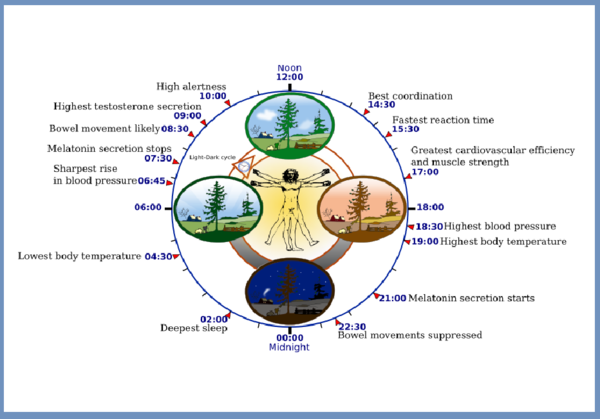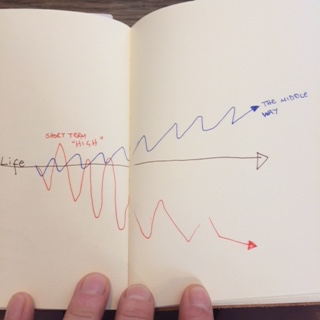Maybe I’m becoming middle aged, or maybe a little less MAD, but recently I seem to be valuing the middle an awful lot. Good Enough, rather than Really Good or Rubbish.
Right for now, instead of right Forever.
I’ve come to realise that really ‘going for it’ can result in a tiring and potentially exhausting cycle where you are repeatedly veering dramatically off course. In contrast, consistently shooting for above average can lead you along a pleasantly meandering route. And the places you find yourself along the way can feel good in that moment, without being couched in hopes for the future or nostalgia for the past.
Ultimately, in life, health and sport, I believe that for most people consistently aiming for ‘Good Enough’ can reinforce positive feelings, and a more linear progression towards improved performance for the long term. The resulting self-efficacy and improved self-esteem can make the journey itself a more fulfilling experience.
In connection with this understanding, with age and wisdom I’m also seeing the value of becoming less judgmental or dogmatic about what is Right and Wrong. And applying the same metaphor of Journeying, I’m learning not to run head long down one path because it seems like THE RIGHT WAY, just in case I change my mind and have to find the energy to go back in the opposite direction.
In health and fitness in particular, the 'right way' can only be right for so long, and the body adapts so fast that you have to keep a constant eye on what is happening for when Right flips back round to Wrong again.
Let me give you a couple of examples from my own life and work:
I became a vegetarian when I was 12, coming home after school one day to tell my mum the exciting news of what I HAD DECIDED. Then, for the next almost decade, I stuck to my guns. So determined and outspoken was I about my healthy choice that I failed to notice that my chosen diet was no longer working for me. That I had become tired, moody, constantly hungry and a bit fat. And so when finally I was no longer able to ignore the screams from my body, and the intellectual information that was creeping into my brain, I had to relent and acknowledge that perhaps this was no longer THE RIGHT WAY.
And so I did what many vegetarians eventually do – I had a bacon Sandwich. It was the year 2000 and I was at the ‘Fitpro’ (fitness professionals) conference in Loughborough. At the time I couldn’t have felt less ‘fit’ or ‘pro’, and something had to give.
Without boring you with the details of the dietary and digestive hoopla that followed, I have no doubt now that the determinism with which I MADE THE DECISION cost me dearly in terms of health, performance and well being. What I failed to account for was that THINGS CHANGE and that this is the only truth that you can really rely on.
Here's another exercise example to illustrate further the dangers of dogma:
I’m not a big fan of ‘crunchies’. You know, old school ‘sit ups’ off the floor. The main reasons for this are that they emphasize flexion (forwards bending) without extension (backwards bending). Most people I deal with already exist in a world of slumpage, where they are flexed over their desks, or they sit on their bikes and flex forward to the handlebars. ‘The crunch’ off the floor can often worsen the poor posture common to the modern world by working the abdominal muscles in a shortened range without any counter-balancing with backwards bending or rotation.
So there, that is my general preach on the matter. However, (and here’s the thing that life has taught me) no sooner had I decided that I AM RIGHT and CRUNCHIES ARE WRONG that the world/the universe/God sent me a client to test my decision. I was approached by a woman in her early 30’s for personal training. Lisa was fairly hypermobile and had back and neck pain having been referred to me by a chiropractor. Every weekend do you know what she liked to do for fun?
Yep, she liked to jump out of planes.
Try this position. Go on. Just laying on the floor and balancing on your hips. It’s pretty extended. In fact it’s a position of hyper-extension. If you’re a stiff desk worker or cyclist reading this you might struggle to get into it at all. Then imagine adding the repeated G forces generated by jumping from thousands of feet several times in an afternoon every weekend and you have a hint of the bio-mechanical stress that my client was putting her body through.
And do you know what makes for an excellent balancing, ‘corrective’ exercise for this kind of shit?
That’s right. A crunchie off the floor. Bollocks.
This case proved conclusively to me that if you push the extremes of exercise repeatedly in the same direction, you end up needing drastic evasive action in the opposite direction to bring you back in to balance. It also proved that you should never judge someone for what they are doing without understanding why they are doing it. RIGHT is only right for a particular person at a particular time.
And so I’ve learnt to qualify my right and wrong, because there will always be an exception. And I’ve realised that any decision or route plan should be qualified in terms of time too:
This is the right direction for me, for now. But I’ve got an eye on where I’ve come from, and where I’m going to.
It’s so bloody obvious really. Especially when dealing with the human body, that staying stuck with one idea is never going to last for long. Life is all about cycles or ‘biological oscillators’. And lets face it, the moment we are conceived we are on our way to death, and one way or another are going to be recycled. That’s what life’s about. That’s karma. That’s planet earth. And that’s what the Lion King teaches us.
But it’s also human nature to want to push the extremes, to feel the excitement of being on the edge and to not only choose our own adventure, but go as hard and fast in that direction as we can. And in sport and exercise in particular, we often celebrate this. But if you push yourself to the edge one way or another and stay there for too long, you may find yourself bouncing uncomfortably from the extremes, which takes the edge off the excitement or makes a drama of the suffering.
Lately, I have attracted a handful of clients who are fed up with the underachievement associated with ‘living life on the edge’ and bouncing back and forth off of those edges. Instead they are choosing the pleasure of progression that you can get from a more moderate plan of action that is more sustainable.
Overtraining is a simple example of where the adrenaline of pushing the boundaries can wear out pretty quick and leave you unable to train the way you want while you recover. Chronic fatigue is a more long-term example of the same problem. Crash dieting is another. The stress-recovery cycle that determines human performance demands that we stay within our biological range, perhaps push it at times, but acknowledge that in pushing it on one edge, we will have to spend time at the opposing edge in order to maximize progress.
Human health and performance is all about these biological oscillations. We sleep at night, we are awake in the day, and during both our hormones and biochemicals are switching from on to off to on again. We train, we break things down, we rest, we build them back up again. And we function in a series of constantly changing rhythms of stress of one sort and recovery of another.
Training (as well as life) is about change. Knowing when to push harder and knowing when to rest, but most of all its about listening to the signs that tell you which to do and when. That is what a coach is there to help you with. To help you read the signs that your body is giving you that can be hard to read when you’re too close to the information. To progress with any plan or program, you have to do just enough to create a positive change. Harder is not always better. After all, overestimating what is consistently possible is what derails most health and exercise programs.
The exercise programs that I design for clients can be pretty precise and people often worry that they won't be ‘DOING IT RIGHT’. I explain to them that I factor this human element into my design, that I’ve chosen exercises that they can do Well Enough to stimulate the changes we want. Perfection is not necessary to make good progress.
Good enough is good enough. Right for now is right for now. That is this middle way, and the middle way leads to good things.





